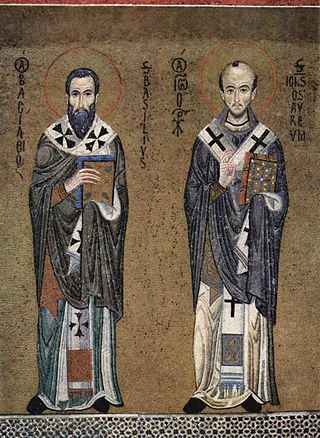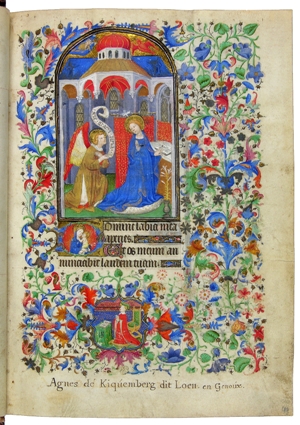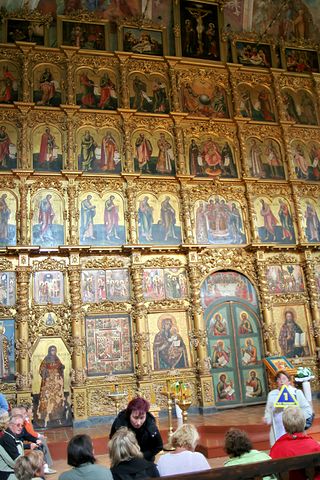
Vespers is a liturgy of evening prayer, one of the canonical hours in Catholic, Eastern Orthodox, Oriental Orthodox, and Lutheran liturgies. The word for this prayer time comes from the [vesper, meaning "evening".

Divine Liturgy or Holy Liturgy is the Eucharistic service of the Byzantine Rite, a liturgical rite developed from the Antiochene Rite of Christian liturgy which is that of the Ecumenical Patriarchate of Constantinople. As such, it is used in the Eastern Orthodox, the Greek Catholic Churches, and the Ukrainian Lutheran Church. Although the same term is sometimes applied in English to the Eucharistic service of Armenian Christians, both of the Armenian Apostolic Church and of the Armenian Catholic Church, they use in their own language a term meaning "holy offering" or "holy sacrifice". Other churches also treat "Divine Liturgy" simply as one of many names that can be used, but it is not their normal term.

In the practice of Christianity, canonical hours mark the divisions of the day in terms of fixed times of prayer at regular intervals. A book of hours, chiefly a breviary, normally contains a version of, or selection from, such prayers.

The Byzantine Rite, also known as the Greek Rite or the Rite of Constantinople, is a liturgical rite that is identified with the wide range of cultural, devotional, and canonical practices that developed in the Eastern Christian church of Constantinople.

Compline, also known as Complin, Night Prayer, or the Prayers at the End of the Day, is the final prayer liturgy of the day in the Christian tradition of canonical hours, which are prayed at fixed prayer times.

The Liturgy of Saint James is a form of Christian liturgy used by some Eastern Christians of the Byzantine rite and West Syriac Rite. It is developed from an ancient Egyptian form of the Basilean anaphoric family, and is influenced by the traditions of the rite of the Church of Jerusalem, as the Mystagogic Catecheses of Cyril of Jerusalem imply. It became widespread in Church of Antioch from the fourth or fifth century onwards, replacing the older Basilean Liturgy of Antioch. It is still the principal liturgy of the Syriac Orthodox Church, the Malankara Orthodox Syrian Church, the Maronite Church, the Syriac Catholic Church, Syro-Malankara Catholic Church and other churches employing the West Syriac Rite. It is also occasionally used in the Eastern Orthodox Church and Melkite Catholic Church. The Malankara Mar Thoma Syrian Church uses a reformed variant of this liturgy, omitting intercession of saints and prayer for the dead.
Christian liturgy is a pattern for worship used by a Christian congregation or denomination on a regular basis. The term liturgy comes from Greek and means "public work". Within Christianity, liturgies descending from the same region, denomination, or culture are described as ritual families.

Beneath Thy Protection is an ancient Christian hymn and prayer. It is one of the oldest known Marian prayers and among the most ancient preserved hymns to the Blessed Virgin Mary that is still in use. A papyrus containing it has been dated as early as the mid 3rd century by some scholars. The hymn is well attested among the believers of the Catholic Church, the Eastern Orthodox Church and Oriental Orthodoxy.

The Anaphora is the most solemn part of the Eucharistic liturgies, such as the Divine Liturgy or the Mass, which serves as a thanksgiving prayer by virtue of which the offerings of bread and wine are consecrated as the body and blood of Christ. This is the usual name for this part of the Liturgy in Greek-speaking Eastern Christianity. In the Eastern Syriac tradition Qudaša is its equivalent. The corresponding part in western Christian liturgy is nowadays most often called the Eucharistic Prayer. The Roman Rite from the 4th century until after Vatican II had a single such prayer, called the Canon of the Mass.
Nones, also known as None, the Ninth Hour, or the Midafternoon Prayer, is a fixed time of prayer of the Divine Office of almost all the traditional Christian liturgies. It consists mainly of psalms and is said around 3 pm, about the ninth hour after dawn.

The West Syriac Rite, also called the Syro-Antiochian Rite and the West Syrian Rite, is an Eastern Christian liturgical rite that employs the Divine Liturgy of Saint James in the West Syriac dialect. It is practised in the Maronite Church, the Syriac Orthodox Church, the Syriac Catholic Church and various Malankara Churches of India. It is one of two main liturgical rites of Syriac Christianity, the other being the East Syriac Rite.

The Euchologion is one of the chief liturgical books of the Eastern Orthodox and Byzantine Catholic churches, containing the portions of the services which are said by the bishop, priest, or deacon. The Euchologion roughly corresponds to a combination of the missal, ritual, and pontifical as they are used in Latin liturgical rites. There are several different volumes of the book in use.

The Alexandrian rites are a collection of ritual families and uses of Christian liturgy employed by three Oriental Orthodox churches, and by three Eastern Catholic Churches.
The Liturgy of Saint Basil or, more formally, the Divine Liturgy of Saint Basil the Great, is a term for several Eastern Christian celebrations of the Divine Liturgy (Eucharist), or at least several anaphoras, which are named after Basil of Caesarea. Two of these liturgies are in common use today: the one used in the Byzantine Rite ten times a year, and the one ordinarily used by the Coptic Church.

The Agpeya is the Coptic Christian "Prayer Book of the Hours" or breviary, and is equivalent to the Shehimo in the Syriac Orthodox Church, as well as the Byzantine Horologion and Roman Liturgy of the Hours used by the Eastern Orthodox Churches and Roman Catholic Church, respectively. The Agpeya prayers are popular Christian prayers recited at fixed prayer times, facing the east by both individuals and families at home seven times a day, as well as for communal prayers as an introduction to Mass at church; this Christian practice has its roots in Psalm 119:164, in which the prophet David prays to God seven times a day. The vast majority of the Coptic Christians learn the recitation and prayers of the Agpeya at an early age as children at home from their families. The Coptic Orthodox cycle of canonical hours is primarily composed of psalm readings from the Old Testament and gospel readings from the New Testament, with some added hymns of praise, troparia, and other prayers.

A liturgical book, or service book, is a book published by the authority of a church body that contains the text and directions for the liturgy of its official religious services.

The Liturgy of Saint Cyril is one of the three Anaphoras used at present by the Coptic Catholic Church and the Coptic Orthodox Church and it retains the liturgical peculiarities which have originated in the early Christian Egypt, thus forming the core of the historical Alexandrian Rite. When reference is made to its Greek Byzantine Rite version, this text is usually known as Liturgy of Saint Mark.

The Liturgy of Saint Gregory the Theologian is one of the three Anaphoras retained by the Coptic Church. The text is named after Saint Gregory of Nazianzus, one of the Cappadocian Fathers.

Orthodox Tewahedo music refers to sacred music of the Ethiopian and Eritrean Orthodox Tewahedo Church. The music was long associated with Zema (chant), developed by the six century composer Yared. It is essential part of liturgical service in the Church and classified into fourteen anaphoras, with the normal use being the Twelve Apostles.
The Eastern Catholic Churches of the Catholic Church utilize liturgies originating in Eastern Christianity, distinguishing them from the majority of Catholic liturgies which are celebrated according to the Latin liturgical rites of the Latin Church. While some of these sui iuris churches use the same liturgical ritual families as other Eastern Catholic churches and Eastern churches not in full communion with Rome, each church retains the right to institute its own canonical norms, liturgical books, and practices for the ritual celebration of the Eucharist, other sacraments, and canonical hours.


















